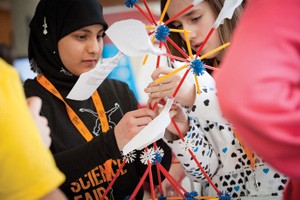Over 200 Montreal area high school and CEGEP students will be pitching research projects in areas ranging from engineering, to health and wellness, to computer software.
“The curiosity and imagination of these young people is astounding,” says Graham Carr, vice-president of Research and Graduate Studies. “They are already tackling some of society’s greatest challenges. I highly encourage all of our community to meet these talented innovators and discover their great work.”
Here is a sample of some of the amazing projects that were on display last year.
Fighting cancer cells — organically
Two students form Westmount’s The Study want to help develop organic cancer fighting drugs that are safer for the body than pharmaceuticals currently found on the market. Tiffany Mach and Catherine Boisvert based their project on research they undertook at the Lady Davis Institute of the Jewish General Hospital, where they tested the effects of natural compounds found in fruit, nuts and leaves on killing cancerous cells.
“We injected cancerous cells with compounds from Indian gooseberries as well as extracts of this fruit. These results were then compared to cells injected with a newly developed pharmaceutical called BKM120,” explains Mach. “We then measured the density of the cancerous cells, in order to analyze the effectiveness of these compounds.”
Results demonstrated that the pharmaceutical killed the most cancer cells of all the compounds tested. However, it also killed normal cells. Interestingly, what Boisvert and Mach found was that the Indian gooseberry compound was the second most effective at killing cancer cells and was a lot less harmful for normal cells.
Helping the blind navigate with wearable technology
Laurier Senior High School student Wilfred Mason is a programmer who’s passionate about assisting the visually impaired better navigate public spaces. Using his basement as his laboratory, he has developed prototypes of several pieces of wearable technology that allow the blind to identify obstacles using vibratory-tactile feedback.
One of the devices is a headband that conveys electro-impulses to the brain, which create vibrations that intensify as a person approaches an object. “I’m also developing a way in which these vibrations can be traced into basic shapes in the brain so that the person wearing the headband can get a sense of an object ahead of them,” he says. “The whole point is to be able to comfortably avoid obstacles.”
Mason has also developed a wristband application that can detect objects from up to three meters away, as well as a vibrating insole that provides the user with an awareness of objects located below the knee.
Attacking cancer at its roots
Under the mentorship of doctors Nahum Sonenberg and Soroush Tahmasebi of the McGill University Health Centre, Jeremy Lebvett of Herzliah High School has been working with a team of scientists trying to determine the potential role of certain proteins in embryonic stem cells.
“We determined that the proteins we investigated allow stem cells to be pluripotent,” says Levett. “This means that these proteins allow stem cells to have the ability to become any other type of cells.”
Such a discovery could have a huge impact on stamping out cancer at its root. “The major problem with chemotherapy is that it can only kill cancer cells and not cancer stem cells,” explains Levett. “Seeing the close relationship between stem cells and cancer stem cells, by knowing the main proteins involved in the pluripotency of cancer stem cells, we can inhibit the formation of these proteins and put an end to the growth of cancer.”
The Hydro-Québec Montreal Regional Science and Technology Fair displays will be set up on the ground floor atrium of the Engineering, Computer Science and Visual Arts Integrated Complex (1515 St. Catherine W.) on the Sir George William Campus.
Public viewings will take place on Sunday, March 13 between 1:30 p.m. and 3:30 p.m., Monday, March 14 between 1:30 p.m. and 3:30 p.m., and Tuesday, March 15 between 8:30 a.m. and 12:30 p.m. and from 1:30 p.m. to 3:30 p.m.
